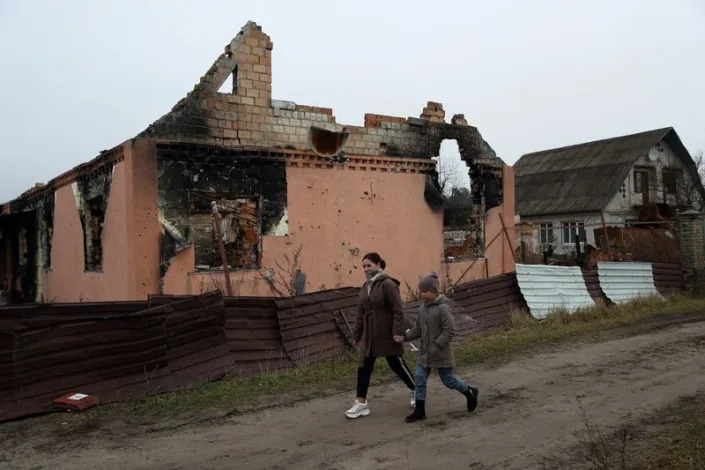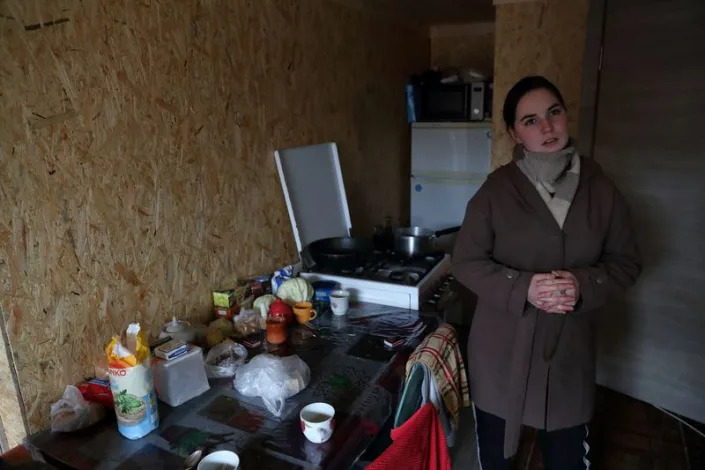Yahoo! News
Finding safe haven in the climate change future: The Midwest
David Knowles, Senior Editor – November 12, 2022
This Yahoo News series analyzes different regions around the country in terms of climate change risks that they face now and will experience in the years to come.
As the negative consequences of rising global temperatures due to mankind’s relentless burning of fossil fuels become more and more apparent in communities across the United States, anxiety over finding a place to live safe from the ravages of climate change has also been on the rise.
“Millions and likely tens of millions of Americans” will move because of climate through the end of the century, Jesse Keenan, an associate professor of real estate in Tulane University’s School of Architecture, told Yahoo News. “People move because of school districts, affordability, job opportunities. There are a lot of drivers and I think it’s probably best to think about this as ‘Climate is now one of those drivers.’”
In late October, a report by the United Nations concluded that average global temperatures are on track to warm by 2.1 to 2.9 degrees Celsius by the year 2100. As a result, the world can expect a dramatic rise in chaotic, extreme weather events. In fact, that increase is already happening. In the 1980s, the U.S. was hit with a weather disaster totaling $1 billion in damages once every four months, on average. Thanks to steadily rising temperatures, they now occur every three weeks, according to a draft report of the latest National Climate Assessment, and they aren’t limited to any particular geographic region.
To be sure, calculating climate risk depends on a dizzying number of factors, including luck, latitude, elevation, the upkeep of infrastructure, long-term climate patterns, the predictable behavior of the jet stream and how warming ocean waters will impact the frequency of El Niño/La Niña cycles.
“No place is immune from climate change impacts, certainly in the continental United States, and throughout the U.S. those impacts will be quite severe,” Keenan said. “They will be more severe in some places and less severe in other places. Certain places will be more moderate in terms of temperature and some places will be more extreme, but we all share the risk of the increase of extreme events.”
In this installment, we look at a region that is already used to weather extremes and where, thanks to climate change, even more are coming into view.
The Midwest
Made up of eight states — Ohio, Michigan, Indiana, Illinois, Missouri, Iowa, Minnesota and Wisconsin — the Midwest has found itself over recent centuries at the intersection of warm, moist air from the Gulf of Mexico and frigid polar vortexes that dip south from Canada. As with other regions of the country, climate change is already upending weather patterns in the Midwest and will, in the years to come, alter precipitation trends, food production, humidity and overall heat in profound ways.
Of the top 10 counties rated safest to live in the Midwest when it comes to climate change risks, six — Menominee, Vilas, Winnebago, Shawano, Portage and Polk — are located in Wisconsin, according to a 2020 analysis by the New York Times and ProPublica based on findings provided by the Rhodium Group, a data analytics firm. The remaining four in the top 10 Midwestern counties — Keweenaw, Luce, Crawford and Alger — are found in Michigan.
Many other counties in those two states and in Minnesota also ranked highly based on a cumulative scale that examined six major categories — heat stress, humidity (“wet bulb”), wildfires, crop loss, sea level rise and overall economic damages — and two emissions scenarios, high and moderate.
While northern counties in the Midwest offer relative protection from climate change risks, those further south, such as Missouri’s Camden, Hickory, Wayne, Bollinger, Dunklin, Maries, Phelps and Ripley counties as well as Illinois’s Alexander and Pulaski counties, all ranked lowest in the region, in large part due to poor scores on farm crop yields, heat and wet-bulb effect.
While many Americans may not yet be familiar with the term “wet bulb,” they certainly will in parts of the Midwest before long. It refers to a potentially fatal combination of hot temperatures and high humidity that conspire to prevent the body from being able to cool itself down through the evaporation of sweat. That dynamic explains why even excessive “dry heat” feels less oppressive than less severe temperatures coupled with high humidity.
NASA predicts that Midwestern states like Missouri and Iowa will “hit the critical wet-bulb limit” in the next 50 years, leading to higher rates of weather-related deaths.
On average, the Midwest can expect dramatic shifts in temperatures if emissions continue at their current pace that will have a wide range of negative effects on human health.
“Compared to other regions where worsening heat is also expected to occur, the Midwest is projected to have the largest increase in extreme temperature-related premature deaths under the higher scenario,” the Centers for Disease Control and Prevention states on its website. “Northern midwestern communities and vulnerable populations that historically have not experienced high temperatures may be at risk for heat-related disease and death.”
As temperatures continue to rise, the Midwest will also find itself dealing with poor air quality, a risk category not included in the New York Times/ProPublica rankings.
“Increases in ground-level ozone and particulate matter are associated with the prevalence of various lung and cardiovascular diseases, which can lead to missed school days, hospitalization, and premature death,” the CDC states. “In the absence of mitigation, ground-level ozone concentrations are projected to increase across most of the Midwest, resulting in an additional 200 to 550 premature deaths in the region per year by 2050.”
The CDC also warns that some of the climate change consequences forecast to hit the Midwest, such as drought, severe flash flooding and diminished air quality, can cause mental health problems like anxiety. Kristi White, a clinical health psychologist in Minneapolis, has already been treating young adults for anxiety born of climate change.
“Some of the things in the patients that I work with are things like asthma exacerbation due to poor air quality from wildfires [and] concerns around the risk for heat-related illnesses during extreme heat waves,” White told Yahoo News earlier this year.
While the climate change risks to the Midwest and other regions of the country have long been predicted by climate scientists using computer modeling, there’s still a large element of surprise when it comes to pinpointing which parts of the region can expect to see extreme weather events and exactly how bad they will be.
In early August, Newton, Ill., was pounded with 14 inches of rain in just 12 hours, according to the National Weather Service. That qualified it as a so-called 1-in-1,000-year rain event, meaning a precipitation event that extreme has only a 0.1% chance of happening in any given year. The deluge would have seemed like more of an anomaly except for the fact that it was the third 1-in-1,000-year rain event — one in Illinois and one each in neighboring Kentucky and Missouri — in a single week.
Indeed, this summer it seemed as though 1-in-1,000-year rain events traveled in threes.
One increasingly glaring problem with rating extreme rainfall events in terms of their historical likelihood is that the changing climate has rendered such scales woefully out of date.
“If you build a statistical model based on a climate that no longer exists, it’s not going to be too surprising that it fails,” UCLA climate scientist Daniel Swain, who also consults for ClimateCheck, a company that provides climate change risk assessments on real estate nationwide, told Yahoo News. Most “hydrologic models and the Army Corps of Engineers” do not factor in the Clausius-Clapeyron equation, which describes the increase in atmospheric moisture that results from every degree of temperature rise, into their modeling, Swain added.
Simply put, more atmospheric moisture can result in more rainfall. Overall, the Environmental Protection Agency has found that rainfall across the Midwest has risen by 5 to 10% in the past 50 years on average. Though average annual rainfall won’t rise at an equal pace across the region, the trend line based on current greenhouse gas projections is clear.
“Precipitation in the Midwest is expected to become more intense, leading to increased flood damage, strained drainage systems, and reduced drinking water availability,” the EPA says on its website.
But the other major aspect of the Clausius-Clapeyron equation is that warmer temperatures dramatically speed up evaporation rates so that even when a region sees an uptick in the amount of annual precipitation, it remains susceptible to drought. In 2021, for instance, 27% of the Midwest experienced a drought, according to the National Oceanic and Atmospheric Administration, including 70% of Michigan and 57% of Iowa.
In 2022, despite record-setting rains in some states, large portions of Iowa, Missouri and Minnesota now find themselves in severe or extreme drought, according to the U.S. Drought Monitor.
To be sure, while the Upper Midwest — including northern Minnesota and Wisconsin and Michigan’s Upper Peninsula — offers cooler average temperatures than other parts of the region, it has also been warming fastest in the region in recent years. Ice on the Great Lakes continues to melt away earlier and wintertime average temperatures across the region have risen significantly. For a little while, that might all seem like good news, sparing residents from the unrelenting winters of past decades. But should emissions continue at their current levels, the changes to the Midwest will be jarring.
A 2020 report by Notre Dame’s Pulte Institute for Global Development noted that “Indiana’s annual average temperature will rise 5 to 6°F by mid-century and as high as 6 to 10°F by late-century, depending on global efforts to reduce greenhouse emissions.”
For Hoosiers, that will mean an increase from seven days per year of temperatures exceeding 95°F at present to between 50 and 89 of them by the end of the century. That heat will, in turn, further decrease crop yields for corn and soybeans, potentially upending a way of life.
In some ways, the Midwest epitomizes the folly of trying to outrun climate change. For every global warming advantage that is offered in places like northern Michigan and Wisconsin, other hazards are poised to present themselves. In its entry on the Midwest, the U.S. Climate Resilience Toolkit highlights those emerging risks.
“Climate change is expected to worsen existing health conditions and introduce new health threats by increasing the frequency and intensity of poor air quality days, extreme high temperature events, and heavy rainfalls; extending pollen seasons; and modifying the distribution of disease-carrying pests and insects,” the website states.









